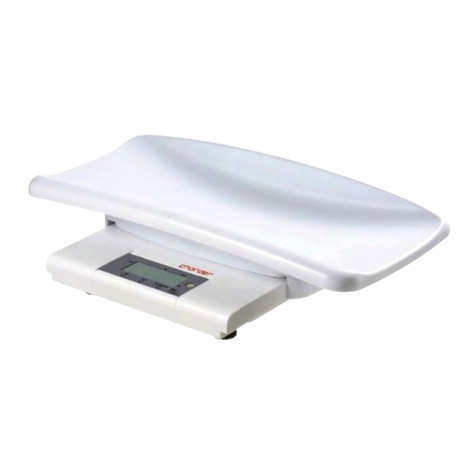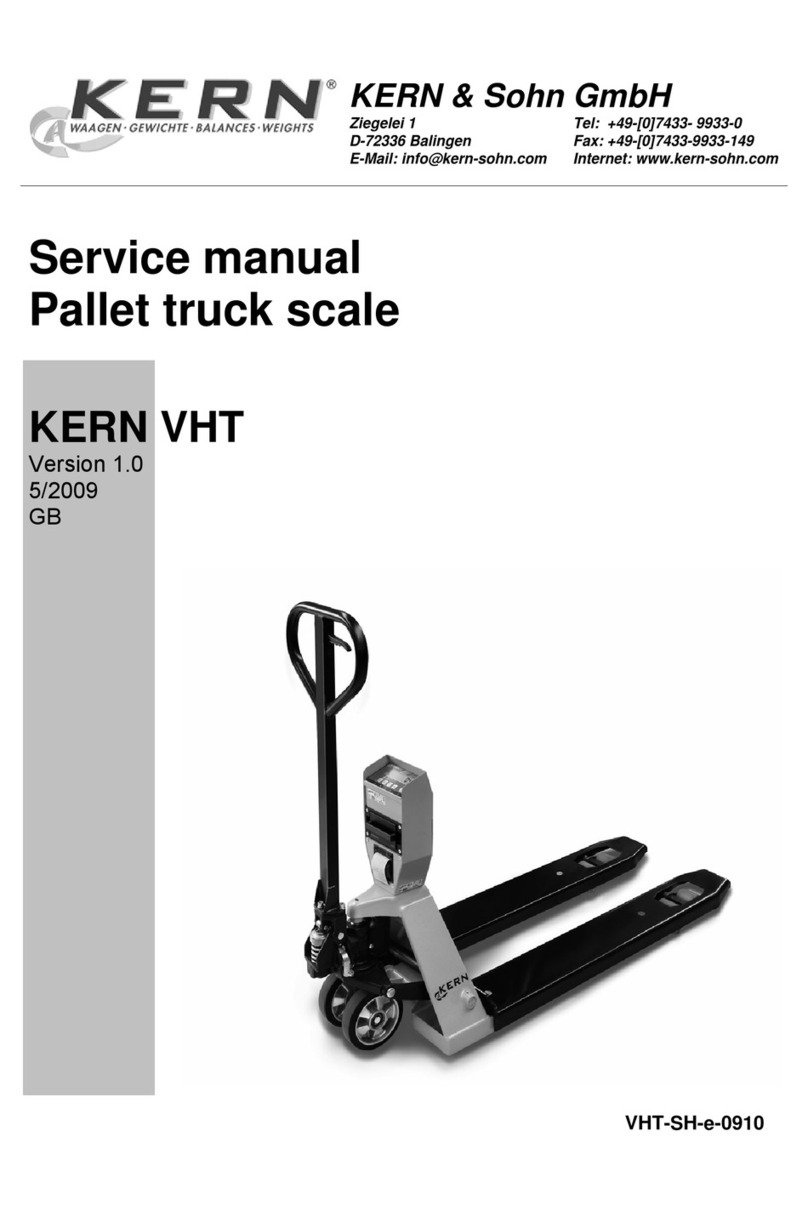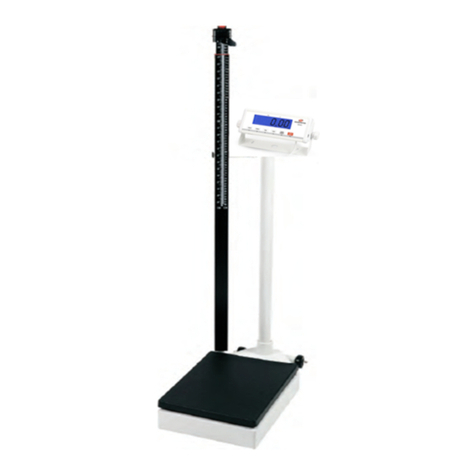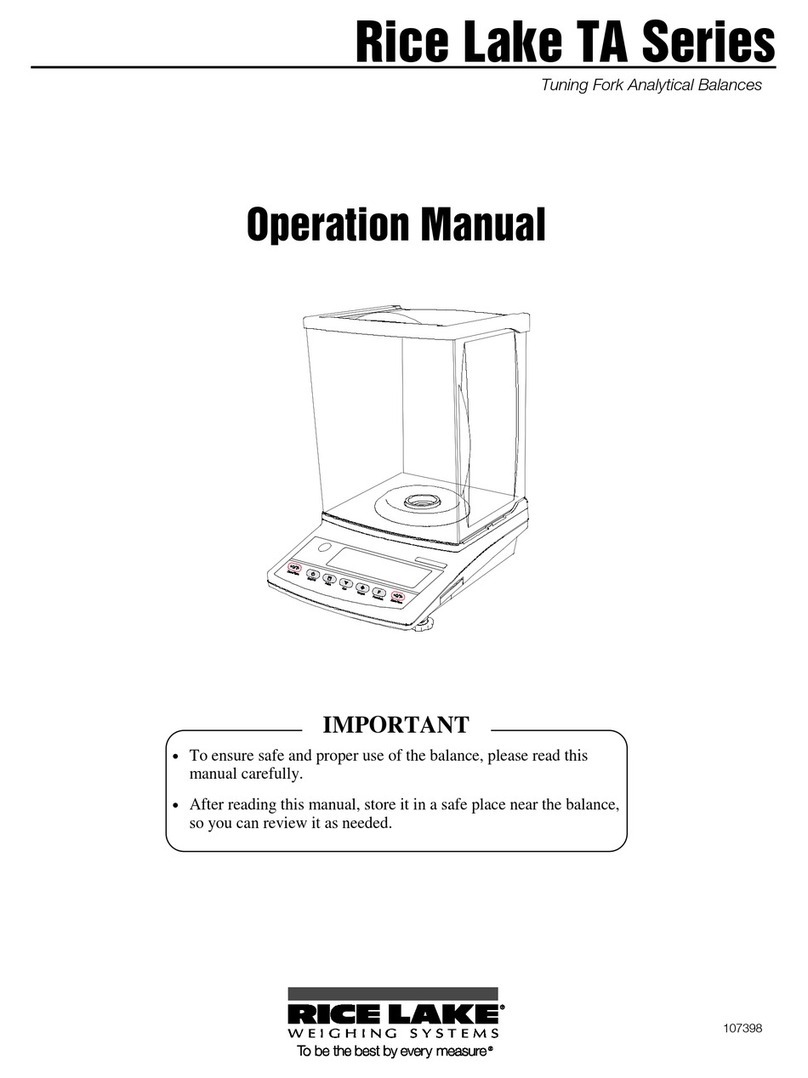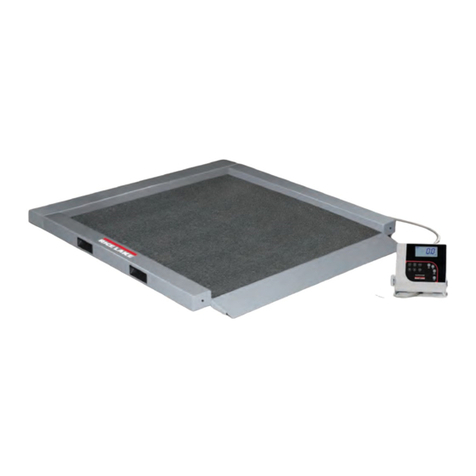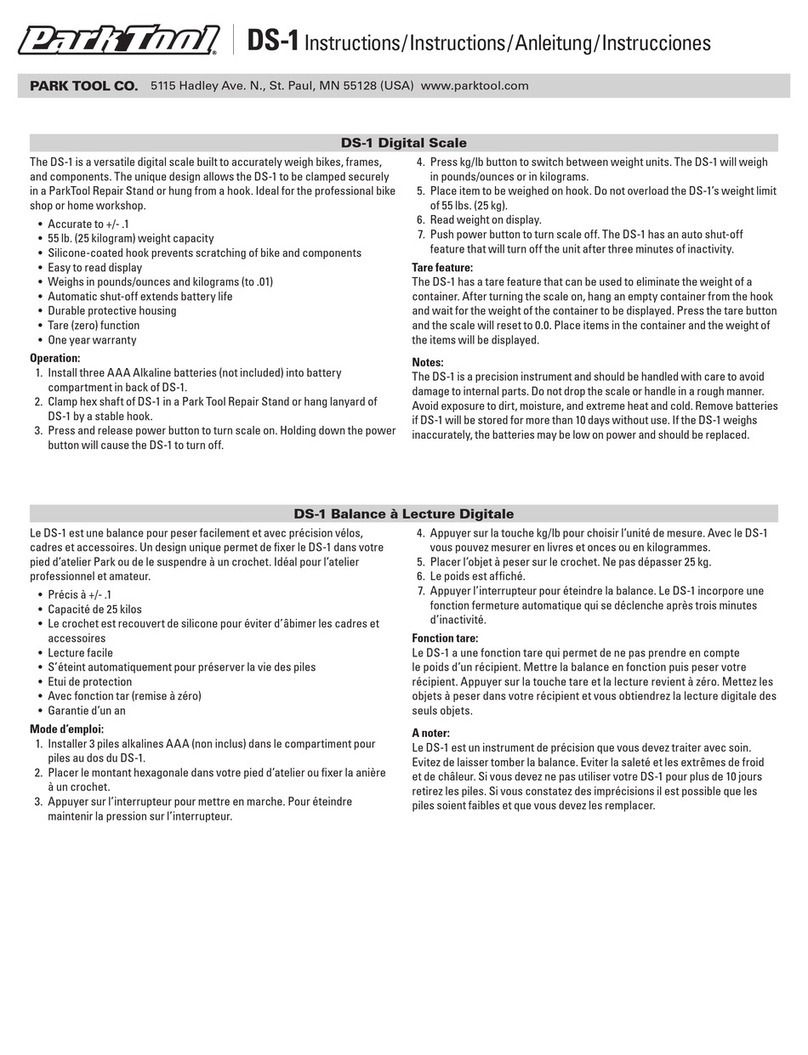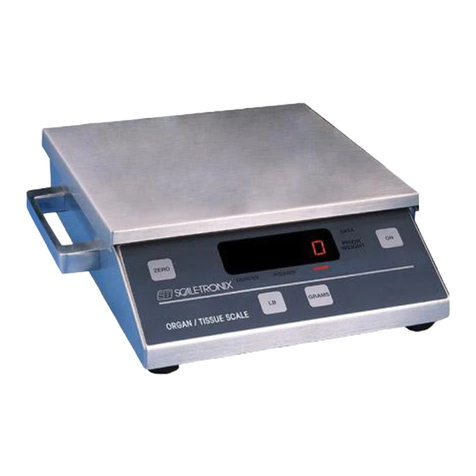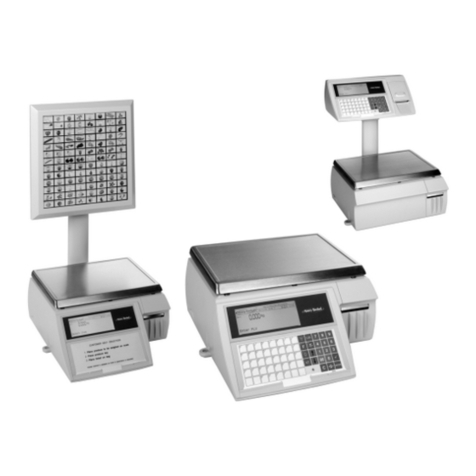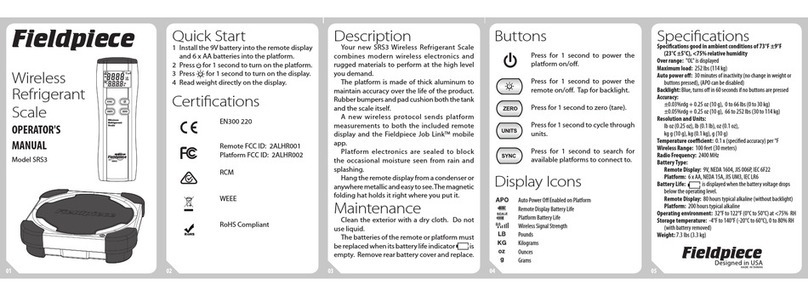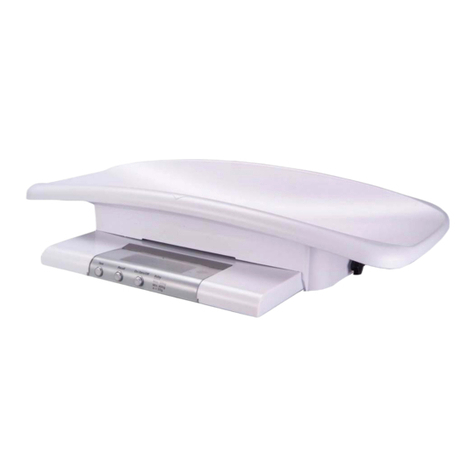BLN nobel G5 User manual

G5 Weighing Instrument
Program version 2.0.1
Technical Manual
PM Legal for trade EN 45501, OIML 76-1


CONTENTS
1. Introduction........................................................ 1-1
General...............................................................1-1
Maintenance.......................................................1-2
Safety information............................................... 1-2
Technical data ....................................................1-3
Ordering information...........................................1-6
2. Installation.......................................................... 2-1
Mechanical installation ....................................... 2-1
Electrical installation...........................................2-2
Connection of cable shields................................ 2-2
Profibus-DP Fieldbus Adaptor............................2-7
DeviceNet Fieldbus Adaptor...............................2-9
ControlNet Fieldbus Adaptor..............................2-11
Front panel.......................................................... 2-12
3. Set-up.................................................................. 3-1
General...............................................................3-1
How to connect a PC to the instrument..............3-2
Menu system ......................................................3-2
Menu structure....................................................3-4
Parameters.........................................................3-6
4. Calibration.......................................................... 4-1
General...............................................................4-1
Common parameters..........................................4-2
Data sheet calibration.........................................4-4
Table calibration ................................................. 4-5
Deadweight calibration ....................................... 4-5
5. Operation............................................................ 5-1
General...............................................................5-1
Power-up sequence............................................ 5-1
Status LEDs........................................................5-1
Display at normal operation................................5-2
Security locks......................................................5-3
Taring.................................................................. 5-4
Gross/Net operation ...........................................5-5
Zero setting.........................................................5-5
Zero-tracking/Automatic zero setting..................5-6
Motion.................................................................5-6
Weight printing....................................................5-7
Long-term Data Store......................................... 5-10
Main Menu..........................................................5-12
Level supervision................................................5-14
Setpoint function.................................................5-15
Digital inputs and outputs ................................... 5-15
Analog output...................................................... 5-15
Filter function......................................................5-16
6. Communication..................................................6-1
General ...............................................................6-1
Serial interface....................................................6-1
Modbus RTU Slave.............................................6-1
Modbus TCP Slave.............................................6-2
FTP Server..........................................................6-3
Modbus protocol..................................................6-3
Fieldbus interface................................................6-24
Fieldbus Data Definitions....................................6-25
7. Remote Access ..................................................7-1
General ...............................................................7-1
Browser requirements.........................................7-1
Using the Remote Access...................................7-2
Security...............................................................7-2
Remote Access Login and Logout......................7-3
Remote / Local Access .......................................7-5
8. Maintenance........................................................8-1
General ...............................................................8-1
File Handling .......................................................8-1
Create Backup ....................................................8-1
Restore Backup...................................................8-1
Set Default ..........................................................8-1
Instrument Restart...............................................8-1
Program upgrade................................................8-2
9. Adaptation for legal weighing...........................9-1
General ...............................................................9-1
Non-Automatic Weighing Instrument..................9-1
Settings affecting legal functions ........................9-5
Parameters not protected by Legal Lock............9-11
Discontinuous Totalizing automatic Weighing ....9-11
Automatic Catchweighing Instrument .................9-12
Labels for legal weighing ....................................9-13
10. Troubleshooting...............................................10-1
General ...............................................................10-1
Error codes..........................................................10-1
Warnings.............................................................10-1

Technical Manual
PRECAUTIONS
READ this manual BEFORE operating or servicing this instrument. FOLLOW these
instructions carefully. SAVE this manual for future reference.
INTENDED USE
The G5 Instrument family are measuring and control devices intended for industrial
systems. Its basic function is to convert the signals from transducers to useful
information. Transducer excitation is included as well as parameter controlled signal
processing, indication of output levels, error supervision and operation of optional
external equipment. The instrument supports several types of communication
interfaces.
INSTRUMENT INSULATION AND GROUNDING
The cable connector for mains power supply should include protective grounding for
safety. The cable for 24VDC power supply (screw terminal connector) should include a
ground connected to terminal GND.
The input groups of the instrument are insulated from each other by functional
insulation. Terminals intended for connection of cable shields are connected to the
protective ground of the mains or GND terminal of 24VDC input but must not be
considered as protective grounding. Shield connection of load cell input is not
connected to mains protective ground or 24VDC GND terminal.
Change description
Revision 0: First release of this document.
!
WARNING
Only permit qualified personnel to install and service this instrument.
Exercise care when making checks, tests and adjustments that must be
made with power on. Failing to observe these precautions can result in
bodily harm.
DO NOT allow untrained personnel to operate, clean, inspect, maintain,
service, or tamper with this instrument.

G5 Weighing Instrument
1-1
1. Introduction
General
The G5 PM Indicator is a high performance single-channel weight indicator (PM model,
panel mounted) intended for industrial systems.
The basic function is to convert the signals from strain gauge transducers to useful
weight information. Transducer excitation is included as well as parameter controlled
signal processing, indication of output levels, error supervision and operation of
optional external equipment.
As long as the error supervision detects no error, a signal called ‘In process’ is then
present but if an error is detected, ‘In process’ will be off and a specific error
message will be displayed. ‘In process’ can be set to control any digital output. Note
that there are weighing channel specific and instrument specific error detection.
All functions in the G5 Instrument are controlled by set-up parameters. Setting of
parameter values can be done from the PM front panel. Maintenance functions can be
accessed locally or remotely.
It is possible to load new software into the instrument using a SD-Card.
The instrument has 4 level supervising functions and 4 set-point functions.
Power supply
The G5-PM (panel mount indicator) is available as 24 VDC model. All input and output
signals are galvanically isolated from the power supply.
Strain gauge input
Both excitation voltage and the output signal from the transducer are measured at the
transducer to avoid influence from voltage drop in the connection cable. Excitation to the
transducer, from the G5 Instrument is provided over separate wires.
A shielded 6-wire cable must be used to connect a distant transducer to the instrument.
The analog signals from the transducer are converted to digital form and filtered to give
an internal transducer signal with high resolution.
The transducer excitation and signal values are combined to form an internal
transducer signal, representing the load on the transducer. Influenced by calibration
data, this signal is converted to a digital measurement value, the weight value, which
can be presented at the local display window and at external equipment.
Communication
The instrument utilizes the serial interface, Ethernet and a fieldbus interface for
communication with control system or computer. The serial interface consists of a RS-
485/RS-422 connection that can be used with 2- or 4-wire connection.
Weight values, level status, error status etc. can be collected and commands given
through the communication interfaces. G5 Instruments can be controlled from a master
computer or PLC using the serial interface, Ethernet interface, field bus interface or
digital I/O.
Modbus RTU protocol is used for the serial interfaces, Modbus TCP and EtherNet/IP
for the Ethernet connection. Optional fieldbus interface for Profibus, DeviceNet or
ControlNet can be used.

Technical Manual
1-2
The serial port can also be used to connect a printer for printing of weight or for
showing weight on an external display unit.
Maintenance
The G5 instrument needs no maintenance, performed by the end-user. Any service
or repair work must be performed by qualified personnel.
Contact your supplier.
Cleaning
Before cleaning the G5, disconnect the power connection to the instrument. Use a soft
cloth to clean the exterior of the instrument. For cleaning the instrument front panel, a
soft, damp, cloth may be used.
Safety information
Utilization.
The instrument may only be utilized for the measurement and control functions,
described in this Technical Manual. It is especially important to adhere to the load limits
of the input/output connectors. We accept no responsibility for any damage arising from
improper operation.
Any changes to the instrument, which causes any function changes, may only be
carried out by the manufacturer or after discussion with and permission by the
manufacturer.
If G5 is used in a manner not specified, the protection provided may be impaired.
Meaning of symbols used in this manual
Direct current.
Alternating current.
!
Caution, risk of danger. Documentation needs to be consulted.

G5 Weighing Instrument
1-3
Technical data
Enclosure
types PM - Panel mount
Enclosure
design Plastic, PC
Dimensions WxHxD 226x126x100 mm
(8.9”x5.0”x3.9”)
Depth behind front 100 mm (3.9”)
Front panel depth 14 mm (0.55”)
Depth not including connectors, screw terminals or cables
Panel cut out WxH 186 ±1 x 91 ±1 mm
Display Color TFT LCD screen with backlighting, 4.3” 480x272 pixels
Keyboard 31 membrane keys
Temperature
range Legal for trade: -10 to +40 °C
Rated performance: -10 to +55 °C
Storage: -25 to +85 °C
Relative
humidity Max. 85% up to 40°C, decreasing linear to 50% at 55°C.
Non-condensing
Rated
pollution Pollution degree 2
Protection IP65 (panel), indoor use
Altitude Up to 2000 m
EMC, RF CE (Industrial)
Serial interface
RS485 For process data and control or printout data to a connected printer.
Isolated by operational insulation
Protocol Modbus RTU, ASCII serial printer
Baud rate Up to 115 kbaud
Cable ratings
Cable rated min 80°C when ambient temperature > 45°C
Cable rated min 70°C when ambient temp. < 45°C and > 35°C
Fieldbus For process data and control (optional)

Technical Manual
1-4
Types Profibus, DeviceNet or ControlNet
USB Version 2.0
USB Memory USB type for PC
For backup and restore of set-up parameters. Operational insulation,
max 500mA output.
SD-Card Micro SD, Micro SDHC types.
Ethernet 10/100BASE-T. For process data, control, file transfer and remote
access.
Protocols Modbus TCP, FTP, http.
RJ45 Indications Orange LED: 100 Mbit/s. Yellow LED: Receiving/Transmitting.
Power supply DC
PM DC model 24 V ±15% including fluctuations, 15W
Impulse withstand (overvoltage) category I of IEC 60364-4-443.
Cable ratings
Cable rated min 80°C when ambient temperature > 45°C.
Cable rated min 70°C when ambient temp. < 45°C and > 35°C.
Load cell input Operational insulation
Excitation voltage: Nominal 10 V. Below is actual excitation shown with 350 ohm load
cells.
1 LC => 9.72V, 2 LC => 9.46V, 3 LC => 9.21V, 4 LC => 8.97V,
5 LC => 8.75V, 6 LC => 8.54V, 7 LC => 8.33V, 8 LC => 8.14V,
Sense voltage Min 1.2V, max 10V. Sense common mode must be within +-0.5V
relative terminal 26 in the load cell input connector.
Max load Maximum 8 (350 ohm)
A/D conversion: 2.4 kHz, 16 000000 units (24 bits)
Input range +/- 3 mV/V
Update rate: 300 weight updates per second
Sensitivity: 0.1 µV
Zero drift: <10 nV/V/K
Span drift: <2 ppm/K
Digital I/O
4 inputs 24 V ±15%, 5 mA from external power supply, isolated by
operational insulation and with common return
4 outputs 24 V ±15%, max 100 mA from external power supply, isolated by
operational insulation and with common return
Cable ratings Cable rated min 80°C when ambient temperature > 45°C
Cable rated min 70°C when ambient temp. < 45°C and > 35°C
Analog output
Resolution 65000 units, 16 bits
Voltage output 0 – 10 V, -10 – 10 V, > 1 kohm load

G5 Weighing Instrument
1-5
Current output 4 – 20 mA, 0 – 20 mA, -12 – 20 mA, -20 – 20 mA,
< 500 ohm load. Current source, i.e. no external power supply
needed.
Update rate 300 Hz
Filter Weight filter + extra smoothing filter (on/off via set-up)
Fieldbus ProfibusDP, DeviceNet and ControlNet.
Fieldbus
data 16 bytes from fieldbus to instrument.
80 bytes from instrument to fieldbus.
See chapter ‘Communication’ section ‘Fieldbus communication interface’ for
details on fieldbus data mapping.
Settings All fieldbus settings are done with setup parameters in the instrument. No
settings are done on the module itself.
Mounting The fieldbus adaptor is mounted in the fieldbus slot with LED’s and connector
accessible.
Remove the plastic cover from the fieldbus slot. Insert the adaptor very
carefully and make absolutely sure that the adaptor slides correctly into the
guides in the connector on the PCB. Tighten the two fastening screws at the
adaptor front and check that the two securing hooks locks into the PCB.
Module
type Profibus-DP DeviceNet ControlNet
Connector Profibus 9-pin, female
D-sub (DB9F) 5 pin male connector. BNC.
Baud rate 9.6 kbps – 12 Mbps or
Auto set by parameter 125, 250, 500 kbps or
Auto set by parameter. Fixed 5 Mbit/s.
Address 1 – 125,
set by parameter 0 – 63,
set by parameter 1 – 99, set by parameter
Bus
Supply
Voltage
According to DeviceNet
(Node) specification:
nominal 24 VDC,
range 11 – 25 VDC.

Technical Manual
1-6
Ordering information
PM model, single channel weighing, 24VDC supply
Denomination: G5-PM-S-DC-S
P/N: 110860 (ordering number).
If an (optional) fieldbus module is needed it must be ordered together with the
instrument. Ordering numbers are shown below. If multiple instruments and/or fieldbus
modules are purchased in the same order it must be clearly specified which module
should be mounted in which instrument.
Optional ProfibusDP fieldbus module
P/N: 110559 (ordering number).
Optional DeviceNet fieldbus module
P/N: 110560 (ordering number).
Optional ControlNet fieldbus module
P/N: 110838 (ordering number).
Example showing product information
and installed option(s).
Label shows:
G5-PM-S-DC-S=> G5, Panel Mount, Single load cell, DC power, Special program.
P/N 110860 => Part Number 110860 = Legal for trade
S/N 16-0199 => Serial Number, first two figures is year
HW v2 => Hardware version 2
Serial Number, Hardware version and Software version can also be found by pushing
INFO-key/Main Menu/System Information.

G5 Weighing Instrument
2-1
2. Installation
Mechanical installation
See chapter Introduction – Technical data for references to PM mechanical
measures: outer extents and body extents.
The safety of any system incorporating the equipment is the responsibility of the
integrator of the system.
Allow at least 20 mm free space around the instrument for ventilation.
PM type instrument:
In an enclosed plastic bag there are four M5x30 hexagon socket head screws and four
fastening brackets.
1. Insert the instrument in the panel cutout.
91mm +-1mm
3.58" +-0.04"
186mm +-1mm
7.32" +-0.04"
4x R max 5 mm
4x R max 0.2"
2. Place a bracket in the corner recession of the rear of the instrument and use the
M5 screw to secure it without tightening it.
3. Place the remaining three brackets and secure each with M5 screws. Tighten the
screws until the brackets start to press against the inside of the panel.
4. Make sure the tip of the brackets is resting against the panel on which the
instrument is mounted and not on the instrument plastic front. This might happen if
the cutout is large.
5. Check that the instrument is positioned
so that the blue front sealing is not
visible through the cutout which might
compromise the sealing properties.
6. When the instrument is properly
positioned tighten the screws 2 – 3
turns. Do not overtighten. Note that the
brackets are flexible.
7. Provide support for the cables to avoid
that strain is applied to the connectors.
Mounting bracket on
the panel mount model

Technical Manual
2-2
Electrical installation
The field wiring of the instrument shall be suitable to the environment
(e.g. chemically) in the end-user application.
Mains cables shall be separated and routed away from SELV or
SELV-E field wiring.
Field wiring installation shall comply with any national regulations, hereunder National
Electrical Code (NEC) for US and/or Canadian Electrical Code for Canada.
•A switch or circuit-breaker shall be included in the building installation.
•The switch shall be in close proximity to the equipment and
within easy reach of the operator
•The switch shall be marked as the disconnecting device for the equipment.
•The equipment switch or circuit-breaker employed as disconnecting device shall
comply with relevant requirements of IEC 60947-1 and IEC 60947-3.
The power supply for the instruments is an external DC source for
G5-PM-S-DC-W
For electrical installation with DC supply, see section DC Supply.
The voltage levels on connectors shall not exceed hazardous voltage levels of 30
Vrms, 42.4 Vpeak or 60 Vdc under normal conditions. In wet locations
these voltage levels shall not exceed 16 Vrms, 22.6 Vpeak or 35 Vdc.
This applies to all accessible parts.
Connection of cable shields
Shielded cables should be used to avoid EMI on the measurement signals or from
entering the instrument. Shields should be grounded in one point of the cable. Avoid
grounding via long and thin leads which will impair the shielding ability of the cable. The
preferable point of grounding is when the cable enters the metal cabinet housing the
instrument. There are a few ways of grounding the cable shield:
1. The absolutely best way of grounding the shield is by using EMI cable glands that
will provide a seamless protection against EMI.
2. Connect the shield to a ground strip inside the cabinet close to the entry point.
3. Connect the shield to a ground terminal inside the cabinet. Always keep the shield
all the way to the instrument.
The following applies to HW version 2 or later. See the System Information menu to
find out the actual HW version of the instrument. The shield of the load cell cable can
also be connected at terminal 26 to achieve best possible noise immunity of the LC
WARNING
Make sure that that the power to the instrument is turned off before
any connections are connected to or disconnected from the
instrument.
Remove connector from instrument when tightening or loosening
screw terminal screws.
!
!
!

G5 Weighing Instrument
2-3
input. Note that terminal 26 is not the grounding point of the load cell cable but it will
extend the shield into the ground plane of the input circuit. Terminal 26 is not
connected to the ground of the instrument.
Communication
External computing devices connected to the communication interfaces of the
instrument have to comply with the standard, UL 60950.
RS422/RS485
The serial communication is made for 2-wire or 4-wire with common 0 V. This is a
SELV/SELV-E circuit.
It can be used for serial communication to computer/PLC (Modbus RTU) or a printer.
Connections are made to terminals 1 – 5. Shielded cable must be used. Shield can be
connected to terminal 6 unless grounded in other point.
The communication lines must be terminated in both ends. Termination switches are
set as shown in the table below:
DIP switch settings
2wire DIP-switches T DIP-switches R DIP-switches
2-wire with termination ON (x2) ON (x2) OFF (x2)
4-wire with termination OFF (x2) ON (x2) ON (x2)
2-wire without termination ON (x2) OFF (x2) OFF (x2)
4-wire without termination OFF (x2) OFF (x2) OFF (x2)
Example of DIP-switch settings.
4-wire with termination
!
1. Tx-
2. Tx+
3. Rx-
4. Rx+
5. Com
6. Shield
1. Tx-
2. Tx+
3. Rx-
4. Rx+
5. Com
6. Shield
RS485, 2-wire RS422, 4-wire

Technical Manual
2-4
Field Bus
Slot for optional Fieldbus interface. Profibus DP-V1, DeviceNet and ControlNet are
available. See section Profibus-DP Fieldbus Adaptor or DeviceNet Fieldbus Adaptor or
ControlNet Fieldbus Adaptor later in this chapter for details.
USB
The USB connector is intended for USB memory only. This port has operational
insulation (from HW version 2). It should be considered as a SELV/SELV-E circuit.
USB Hub is not supported.
Ethernet
This is a SELV circuit. Use a category 5 cable to connect to a PC (point to point
connection) or to connect to other equipment through a switch, hub or router. Use an
electrically isolating network device if the instrument is being connected to the public
network.
DC supply
The output of the external DC source must be rated 24 V , ±15%
including fluctuations, min. 15 W. The DC source must provide Double
Insulation between Mains parts and 24 V SELV or SELV-E Circuit, and a
limited-energy circuit (maximum available current of 8 A). For the US
market this energy limit can be achieved with an ANSI/UL248-14 fuse rated 5A. For
other markets an IEC 60127 T type fuse rated 4A may also be used.
24 VDC power is connected to terminals 19, 20 and 21. The G5 instrument should be
powered by 24 V , connected according to the diagram below. To achieve functional
grounding, terminal 21 should be connected to ground.
See Technical data for input voltage ratings.
19. +24 VDC
20. 0V
+
-21. PE
+24 VDC
power supply
!

G5 Weighing Instrument
2-5
Load cell connection
Terminals 22 – 29, transducer connection and cabling should be handled with great
care to achieve good measurement of data. Transducer integrated cables may not be
shortened.
4-wire connection can be used if the transducer integrated cable is long enough to
be connected directly to a transducer input. With a 4-wire connection Sense+ must
be connected to Exc+ and Sense- must be connected to Exc-.
6-wire connection should be used if the integrated cable must be lengthened
or if several transducers should be connected to one transducer input.
The transducer input is insulated by operational insulation and the shield should be
connected to the most convenient ground/earth point. This can be the junction box
when using multiple transducers, at the cable entry to the enclosure where the G5 is
mounted or at the barrier ground when using Ex zener barriers.
Shield can be connected to terminal 26 if the instrument is of HW version 2 or later.
On the transducer cable next to the terminals 22-29 shall two STAR-TEC Snap
Ferrite with safety key technology, part number 74271112 from Wurth or equal be
placed.
In the junction box SL-4 from BLH Nobel all necessary terminals and
interconnections are provided.
29. TEDS+ (NC)
22. Exc+
23. Sense+
24. Exc-
25. Sense-
26. TEDS- (NC)
27. Sign+
28. Sign-
E+
E-
S+S-
Junction box
Connection of transducer(s)
NOTE! Transducer cables must be routed at least 200 mm away from
230/400 V, 50/60 Hz power cables. By cables with other frequencies or
high power, an even wider distance is preferable.

Technical Manual
2-6
Solid state relay outputs
Digital outputs use terminals 7 to 10 with terminal 11 (OCom) as the common
connection. Four digital outputs are provided with contact rating given in Technical
data. External 24 VDC power supply must be used. Note that either the positive or the
negative pole of the voltage source (24 V ) can be connected to OCom (11).
Shielded cable/cables should be used and the shield can be connected to terminal 12 if
it’s not possible to ground it in another point.
7. Out 1
8. Out 2
9. Out 3
10. Out 4
11. OCom
+
-
12. Shield
+
-
Alternative
connection
Digital inputs
Digital inputs use terminals 13 to 16 with terminal 17 (ICom) as the common
connection. Four digital inputs are provided, with functions that can be set in the G5
set-up. External 24 VDC power supply must be used. Note that either the positive or
the negative pole of the voltage source (24 V ) can be connected to ICom (17).
Shielded cable/cables should be used and the shield can be connected to terminal 18 if
it’s not possible to ground it in another point.
13. In 1
14. In 2
15. In 3
16. In 4
17. ICom
+
-
18. Shield
+
-
Alternative
connection
Analog input and analog output
Terminals 38 (Vi) and 39 (Comi) are used for the +-10V auxiliary analog
input of the instrument. The analog output is connected to terminals 41
(Como and output signal to terminal 42 (Vo1/Io1). The analog output is either
voltage or current loop. Como and Comi are internally connected.
Shielded cable/cables should be used and the shield can be connected to the shield
terminal 40 if it’s not possible to ground it in another point.
38. Comi
39. Vi
40. Shield
41. Como
42. Vo1/Io1
+
-
V/A
Analog input: +-10V
Analog output:

G5 Weighing Instrument
2-7
Profibus-DP Fieldbus Adaptor
Profibus module front view
(1) Operation mode LED.
(2) Status LED.
(3) Profibus connector.
Operation mode LED
State Indication
Off Not online / No power
Green On-line, data exchange
Flashing Green On-line, clear
Flashing Red (1 flash) Parameterization error
Flashing Red (2 flashes) Profibus configuration error
Status LED
State Indication
Off No power or not initialised
Green Initialised
Flashing Green Initialised, diagnostic event(s) present
Red Exception error
OP ST
PROFIBUS DP-V1
(1) (2)
(3)

Technical Manual
2-8
Profibus connector (DB9F)
Pin Signal Description
1 - -
2 - -
3 B line Positive RxD/TxD, RS485 level
4 RTS Request to send
5 GND Bus Ground (isolated)
6 + 5V Bus Output +5V termination power (isolated)
7 - -
8 A line Negative RxD/TxD, RS485 level
9 - -
Housing Cable shield Functional ground internally connected to the
module protective ground via cable shield
filters according to the Profibus standard.
For connection of the adaptor to the Profibus master, use a Profibus standard cable
and connector according to the diagram below.
8. A-Line
3. B-Line
Shield
For reliable fieldbus function, line termination must be arranged in both ends of the
transmission line. For a G5 instrument, at the end of the cable, a connector with line
termination should be used. For all other G5 Instruments, connection without line
termination should be used.
For configuration of the adaptor, a GSD file (VISH0F83.GSD) is available and should
be installed in the master.
Select the 8 words output module + 2 x 16 words input modules + one 8 words input
module. This will give 16 bytes of output data and 80 bytes of input data. The PLC set-
up should match this exactly including the order of the input modules.

G5 Weighing Instrument
2-9
DeviceNet Fieldbus Adaptor
DeviceNet module front view
(1) Network Status LED.
(2) Module Status LED.
(3) DeviceNet connector.
Network Status LED
State Indication
Off Not online / No power
Green On-line, one or more connections are established
Flashing Green (1 Hz) On-line, no connections established
Red Critical link failure
Flashing Red (1 Hz) One or more connections time out
Alternating Red/Green Self-test
Module Status LED
State Indication
Off No power
Green Operating in normal condition
Flashing Green (1 Hz) Missing or incomplete configuration
Red Unrecoverable fault(s)
Flashing Red (1 Hz) Recoverable fault(s)
Alternating Red/Green Self-test
NS MS
DeviceNet
(1) (2)
(3)
(Pin 1)

Technical Manual
2-10
DeviceNet connector
Pin Signal Description
1 V- Negative bus supply voltage
2 CAN L CAN low bus line
3 Shield Cable shield, functional ground.
4 CAN H CAN high bus line
5 V+ Positive bus supply voltage
For connection of the adaptor to the DeviceNet master, use a standard cable for
DeviceNet or similar shielded cable with twisted pairs and a connector according to the
diagram below. The bus supply voltage shall be 11 – 25 VDC.
2. CAN L
4. CAN H
1. V-
5. V+
3. Shield
For reliable fieldbus function, line termination must be arranged in both ends of the
transmission line. For a G5 Instrument placed at the end of the line, terminate line by
placing a 121-ohm resistor between CAN L (pin 2) and CAN H (pin 4).
For configuration of the adaptor an EDS file is supplied with the instrument that should
be installed in the master. Note that the EDS file is a generic type supplied by the
module manufacturer. The file doesn’t contain any reference to the G5 Instrument or to
BLH Nobel.
Table of contents





